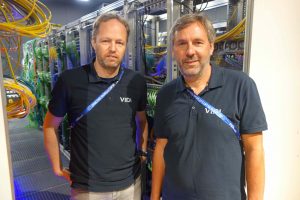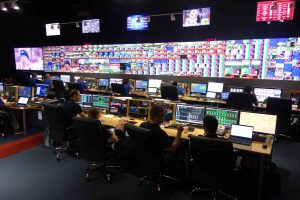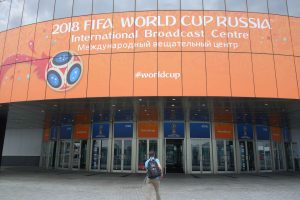Live from FIFA World Cup: VIDI network delivers video and data from match venues
Live video and data networks, conceptualised and operated by the VIDI team in Russia, are being watched worldwide during the 2018 tournament.
To ensure that it all works, VIDI installed and tested the adaption technology in advance at all 12 match venues as well as in the International Broadcast Centre (IBC) in Moscow.

VIDI Owner and Technical Director Karsten Winterburg (left) with Event Service Director Robert Oszvald in the Central Equipment Room (CER) at the IBC in Moscow
At the IBC VIDI Owner and Technical Director Karsten Winterburg told SVG Europe, “We deliver all the live material from the venues back to the IBC. And at the 13th venue, the outside presentation studios at Red Square, we also transmit all the video and data feeds between that location and the IBC, back and forth.
“And on top of that we have a co-operation with Eurovision under which we are doing all the international feeds; every international customer going out of the IBC is served jointly by Eurovision and VIDI. This is a huge operation in terms of international feeds, agreed with HBS,” said Winterburg.
VIDI Director Event Service Robert Oszvald added, “We have three flight cases at each venue for video and data. We provide 140 video ports to each venue: this could be from HD 1080i up to 8K, for customers like NHK for their 8K transmissions.
“We have two people at each venue and nine here at the IBC, plus one engineer from our Russian partner at each venue and one more here. Our interface is HD-SDI and then we hand over into the network from Russian telco MegaFon, and that’s part of HBS and FIFA responsibility. The network is monitored by us but is not our responsibility,” said Oszvald.
“We are contracted to a Russian company called Synterra Media; they have the State contract from the Russian government. We are, let’s say, indirectly serving HBS: in 2014 we had a direct contract with HBS but this time all parts which have to be provided by the government are with a Russian company,” he said.
“Our team has a telco and broadcast background,” explained Winterburg, “and we understand where the problems are going to come from in live broadcasting. Normally telco guys don’t understand live video as they’re usually transmitting data. It doesn’t matter to them what is in the data.
“The protocol for all of this is IP, and we did our first IP transmission for video back in 2006. For us it’s a common interface, common protocol and common procedure,” he said.
After more than two years of intensive planning and preparation, the VIDI advance party made its way to Moscow in early May to begin the construction and operation of the contribution network for live broadcasts. Engineers reported the enormous network ‘ready for service’ two weeks later.
And since June 14, the live broadcasts of the World Cup matches have been transmitted via this system. In addition to the transport of live video signals, the network also provides significant data options and services.
The carrier connections have been realised via the network of the Russian telco MegaFon. The local cooperation and contract partner for the entire project is CSJC Synterra Media.
The installation and set-up of the network was a mammoth task. A complex network topology with the provision of double signal paths was set up as a fail-safe. In the event of problems, it is possible to switch to the backup channels using hitless switching technology without interrupting the viewers.
Transmitting from venues to the IBC
Audio and video data of the cameras is received, processed and forwarded to the IBC, located in the Crocus Expo International Exhibition Centre in Moscow. Every goal, every pass and every save goes through the IBC.
Moreover, extensive file services are also realised via these connections. This is a challenging task for

Inside the giant Master Control Room at the IBC
the VIDI engineers, who are tasked with handling the signal transmissions sent from the individual stadiums to the IBC and forwarding them around the globe to the many rights holders.
The video and data adaption technology set up in the IBC consists of 20 MD8000 and 12 MDP3020 Media Links devices with a total of 804 video ports and 128 1G data ports. The video signals are broadcast in 1080p (3G), UHD (4K) and sporadically in Super Hi-Vision (8K).
The network is integrated via 104 redundant 10G connections. All video signals are compressed with hitless protection and as JPEG2000. The 10G data services are also hitless protected.
Furthermore, the VIDI team also supports additional contribution and service paths to the IBC. For example, to Red Square in Moscow, which is home to several outside presentation studios. This integration for video and data applications has been realised as 9x 10G connection. And the path is run redundantly which means that a total of 18x 10G are available. To this end, the broadcasters are provided with protected 10G and 1G services.
The connection to the IBC in Moscow is established via six redundant 10G network lines. All services were thoroughly tested beforehand. For example, complex power-down scenarios, during which the power for the adaption technology had to be supplied from an internal UPS system for at least 15 minutes, had to be mastered.

Exterior of the IBC building at the Crocus Expo International Exhibition Centre in North West Moscow
As always, quality and security of the solution was the focus in this network design. That’s why the Network Management System (NMS) from VIDI also serves as the central tool in Russia for monitoring all signal connections and ensuring transmission quality.
In the IBC in Moscow and the network monitoring rooms at the game venues, access to the NMS monitoring system was established. Thus the VIDI engineers have access to the monitoring results from each of these locations and can also manage the network via this access.
